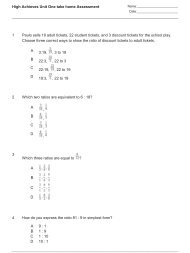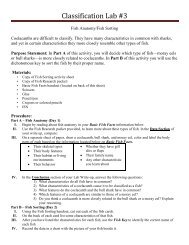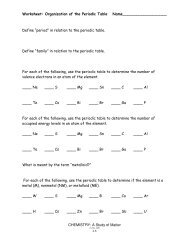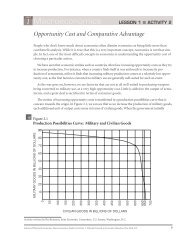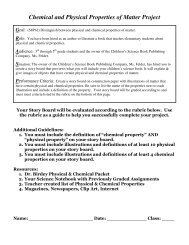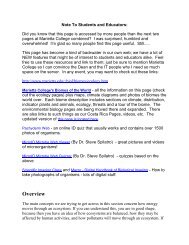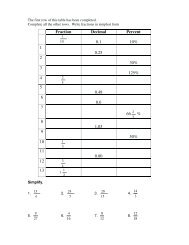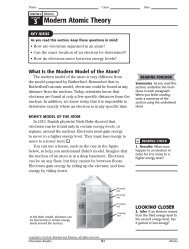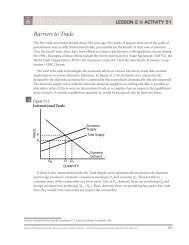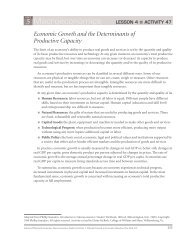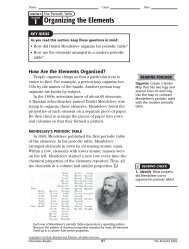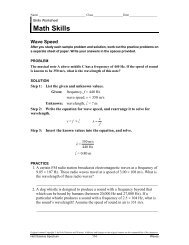Geography Final Exam 2011.pdf - CommunityNet: DeKalb County ...
Geography Final Exam 2011.pdf - CommunityNet: DeKalb County ...
Geography Final Exam 2011.pdf - CommunityNet: DeKalb County ...
Create successful ePaper yourself
Turn your PDF publications into a flip-book with our unique Google optimized e-Paper software.
JBoss Developer Studio 4.1 4.1.2 Release Notes 3AbstractThese release notes contain important information related to the JBoss Developer Studio. New features,known issues, resources, and other current issues are addressed here.
World <strong>Geography</strong> <strong>Final</strong> <strong>Exam</strong>____ 36.____ 37.____ 38.____ 39.____ 40.____ 41.____ 42.____ 43.____ 44.____ 45.Geographers developed the field of urban geography to studyA. the ways in which proximity to natural resources affects city life.B. the contrasts between cities and small towns.C. the rate at which populations are shifting to cities.D. the ways in which people use space in cities.A city, along with its suburbs and exurbs, formsA. a megalopolis.B. a Central Business District (CBD).C. a metropolitan area.D. an urban lifestyle.Urbanization is theA. pattern through which the customs of one city spread to other cities.B. dramatic rise in the number of cities and the resultant lifestyle changes.C. overdevelopment of exurban areas and overuse of natural resources.D. worldwide spread of advanced technologies.Basic land use patterns found in all cities includeA. residential, industrial, and commercial.B. agricultural, merchandising, and technical.C. residential, technical, and educational.D. industrial, commercial, and religious.The commercial core of a city is called itsA. megalopolis.B. metropolitan area.C. Central Business District (CBD).D. urbanization hub.The Aztec Empire fell under the rule of Spain as a result ofA. diffusion.B. the Spanish conquest.C. the Free Trade Agreement.D. manufacturing.The Aztec city that became the site of Mexico City was calledA. Augustín.B. Juárez.C. Texcoco.D. Tenochtitlán.In 1929, the new political party that helped introduce democracy in Mexico was called theA. Institutional Revolutionary Party.B. Democratic Party.C. National Action Party.D. Multi-Party.Factories along the U.S. border that manufacture goods for export are calledA. finance development.B. maquiladoras.C. trade agreement factories.D. import tariff industries.NAFTA is an important trade agreement that promotes the economic prosperity ofA. Mexico, the United States, and Spain.B. Mexico and Spain.C. Mexico and the United States.D. Mexico, Canada, and the United States.<strong>Geography</strong> 2011 5
World <strong>Geography</strong> <strong>Final</strong> <strong>Exam</strong>____ 46.____ 47.____ 48.____ 49.____ 50.____ 51.____ 52.____ 53.____ 54.Which of the following two cultures blended to shape the development of Mexico?A. Spanish and PortugueseB. native peoples and SpanishC. Maya and AztecD. Spanish and AfricanWhich of the following was the name of the capital of the Aztec Empire?A. YucatánB. QuetzalcoatlC. TenochtitlánD. Mexico CityWhich of the following is expected to contribute to Mexico's economic prosperity?A. rising populationB. NAFTAC. human-environment interactionD. National Action PartyThe economies of Central America and the Caribbean are primarily based on which of these twofactors?A. agriculture and industryB. trade and industryC. tourism and industryD. agriculture and tourismWhich of the following are the major groups of people that shaped the cultures of both CentralAmerica and the Caribbean?A. native peoples, Europeans, AfricansB. native peoples, Spanish, PortugueseC. Spanish, French, DutchD. Inca, Maya, SpanishWhich of the following was developed to make member economies more stable?A. QuechuaB. United Provinces of Central AmericaC. MercosurD. Treaty of TordesillasWhich of the following combines a Brazilian dance with African influences?A. sambaB. capoeiraC. cariocasD. CarnivalWhich of the following countries has both the largest territory and population of any country in LatinAmerica?A. BoliviaB. BrazilC. ArgentinaD. ChileWhich of the following two countries gained control of the land in South America as a result of theTreaty of Tordesillas?A. United States and PortugalB. Spain and FranceC. Spain and PortugalD. Germany and Italy<strong>Geography</strong> 2011 6
World <strong>Geography</strong> <strong>Final</strong> <strong>Exam</strong>____ 55.____ 56.____ 57.____ 58.____ 59.____ 60.____ 61.____ 62.____ 63.Which of the following identifies the reason why the Portuguese brought Africans to the colony ofBrazil?A. to work on the sugar plantationsB. to build citiesC. to clear landD. to mine gold and silverWhat is exchanged in a debt-for-nature swap?A. payment of debt for protection of part of the rain forestB. money for productsC. timber for farmlandD. oxygen for carbon dioxideWhich of the following is NOT an aspect of global warming?A. buildup of carbon dioxide in the atmosphereB. increase in temperaturesC. decrease in temperaturesD. climate changesBiodiversity refers to a wide range of which of the following species?A. plantsB. insectsC. wildlifeD. all of the aboveWhich of the following have contributed to the deforestation of the Amazon rain forest?A. demand for hardwoods such as mahogany and cedarB. clearing of land for farmingC. clearing of forest for cattle to grazeD. all of the aboveWhat is the most important reason that many Latin American citizens are unable to take advantageof the free-market economy?A. They live in crowded cities.B. They lack education and cannot get meaningful jobs.C. They live in rural areas.D. They have many diseases.Which of the following best describes the form of government known as an oligarchy?A. government by a few powerful rulersB. a government based on constitutional freedomsC. an opposition governmentD. a Spanish governmentWhich of the following is the goal of land reform?A. to support growing citiesB. to reduce inflationC. to divide land and wealth more fairlyD. to end military leadership in governmentWhich term describes a government under harsh, military leadership?A. JuntaB. democracyC. oligarchyD. caudillo<strong>Geography</strong> 2011 7
World <strong>Geography</strong> <strong>Final</strong> <strong>Exam</strong>____ 64.____ 65.____ 66.____ 67.____ 68.____ 69.____ 70.____ 71.____ 72.Which of the following is NOT associated with a democracy?A. free speechB. fair electionsC. citizen participationD. lack of participation for all except the powerful rulersWhich of the following describes Juan Perón of Argentina and other 20th-century Latin Americandictators?A. political reformerB. caudilloC. opposition leaderD. elected officialWhich of these peninsulas is bounded by the Norwegian Sea, theNorth Sea, and the Baltic Sea?A. BalkanB. ItalianC. IberianD. ScandinavianWhich of the following best describes the Northern European Plain?A. Flooding prevents the land from being cultivated.B. A lack of pesticides results in low production.C. A variety of crops are produced in abundance.D. Air and water pollution have destroyed the land.Which of these landforms contributed most to the development of ethnic differences in Europe?A. seasB. islandsC. mountainsD. plainsThe "Land of the Midnight Sun" includes which of these countries?A. AustriaB. IrelandC. PortugalD. FinlandWhich of the following best explains the deforestation on the Scandinavian Peninsula?A. High tides bring a killer algae to the area, and the algae contaminate the water needed by trees.B. Winds blow emissions there from an industrial region, and those emissions cause acid rain.C. Windmills in the Netherlands blow emissions from Dutch factories.D. Too many trees are cut down for use in home construction and in paper mills.Which of these best explains why Italy did not industrialize as early as its neighbor France?A. more tourismB. fewer resourcesC. greater land areaD. fewer mountain rangesWhich of the following is NOT a possible reason to create polders?A. to gain more farmlandB. to gain protection from invading armiesC. to reduce population densityD. to reduce erosion caused by waves<strong>Geography</strong> 2011 8
World <strong>Geography</strong> <strong>Final</strong> <strong>Exam</strong>____ 82.____ 83.____ 84.____ 85.Which region of Europe has great diversity because of its history as a cultural crossroads?A. Mediterranean EuropeB. Western EuropeC. Northern EuropeD. Eastern EuropeWhich of these is NOT part of the artistic legacy of Western Europe?A. painting in the NetherlandsB. music in GermanyC. painting in FranceD. painting in SwitzerlandWhich of the following would be found in a region that had undergone balkanization?A. several small, hostile statesB. many natural resourcesC. an increase in populationD. heavy industrial pollutionWhat spread from Asia to Europe and caused the deaths of millions of people?A. smallpoxB. bubonic plagueC. VikingsD. Ottomans____ 86. Which of these countries was torn apart by conflict in the 1990s?A. RomaniaB. BulgariaC. HungaryD. Yugoslavia____ 87.____ 88.____ 89.____ 90.Which of these was NOT a cause of recent conflict in the Balkans?A. religious differencesB. economic alliancesC. anger over past conflictsD. nationalistic feelingsWhich of the following was Serbia's policy toward Bosnia and Herzegovina's Muslims and Croats?A. peaceful coexistenceB. divide and conquerC. ethnic cleansingD. diplomatic negotiationWhich of the following best describes the international response toward Serbia's actions in the1990s?A. military interventionB. negotiated settlementsC. economic boycottD. all of the aboveWhich of these best explains why Poland's water is unsafe to drink?A. not enough sewage treatment plantsB. industrial waste from RomaniaC. killer algaeD. all of the above<strong>Geography</strong> 2011 10
World <strong>Geography</strong> <strong>Final</strong> <strong>Exam</strong>____ 91.____ 92.____ 93.____ 94.____ 95.____ 96.____ 97.____ 98.____ 99.What is the purpose of the European Environmental Agency?A. to set government standardsB. to monitor chemical fertilizersC. to enforce controlsD. to provide informationWhy is international cooperation needed to solve the problem of pollution?A. so the euro can be used to pay for the cleanupB. because pollution spreads across national boundariesC. because cleanup is the responsibility of the United NationsD. because individuals refuse to obey national lawsHow did the formation of the Common Market affect the economies of its members?A. They experienced runaway inflation.B. Trade among members quadrupled.C. Unemployment rates doubled.D. Industries fled to nonmember nations.Which of the following might create problems for the EU if former Communist nations become EUmembers?A. They are less prosperous.B. They are more industrialized.C. They have stricter pollution controls.D. They pay their workers higher wages.What does the incident with Joerg Haider demonstrate about the EU?A. It prosecutes criminals.B. It regulates banking officials.C. It influences national politics.D. It avoids controversy.The mountain range that separates the Northern European and West Siberian plains is theA. Transcaucasia Mountains.B. Caucasus Mountains.C. Siberian Mountains.D. Ural Mountains.The Caucasus Mountains form the border betweenA. Russia and Transcaucasia.B. Siberian Plain and Georgia.C. Caucasian Plain and Tian Shan.D. Siberian Plains and Yenisey River.The fertile soil found on the Northern European Plain is known asA. tundra.B. permafrost.C. chernozem.D. plain.The longest river on the European continent is theA. Syr Darya.B. Amu Darya.C. Volga River.D. Irytsh River.<strong>Geography</strong> 2011 11
World <strong>Geography</strong> <strong>Final</strong> <strong>Exam</strong>____ 100.____ 101.____ 102.____ 103.____ 104.____ 105.____ 106.____ 107.____ 108.The oldest and deepest lake in the world isA. Czar Lake.B. Lake Caspian.C. Aral Sea.D. Lake Baikal.A region known for frigid temperatures as well as its many natural resources isA. Siberia.B. Georgia.C. Russia.D. Uzbekistan.__________ is the term used to describe a region's distance away from the moderating influenceof the sea.A. continentalityB. taigaC. tundraD. precipitationOne type of vegetation that is NOT found in Russia and the Republics isA. forest.B. steppe.C. tundra.D. swamp.The _________ was damaged by efforts to use its waters for irrigation of nearby farms.A. Caspian SeaB. Aral SeaC. Black SeaD. White SeaThe term that is used to describe the permanently frozen subsoil in Siberia isA. frosted.B. frozen.C. permafrost.D. tundra frost.Latvia, Lithuania, and Estonia are known asA. the Western Republics.B. the Soviet Union.C. the Baltic Republics.D. the Balkans.The Russian leader who put an end to Mongol rule wasA. Ivan the Great.B. Catherine the Great.C. Peter the Great.D. Joseph Stalin.In 1917, the rule of the czars was ended byA. the Cold War.B. the First World War.C. the Mongol invasion.D. the Russian Revolution.<strong>Geography</strong> 2011 12
World <strong>Geography</strong> <strong>Final</strong> <strong>Exam</strong>____ 109.____ 110.____ 111.____ 112.____ 113.____ 114.____ 115.____ 116.____ 117.The leader who granted more economic and political freedom to the people of the former USSRwasA. Ivan the Great.B. Mikhail Gorbachev.C. V. I. Lenin.D. Joseph Stalin.An economy in which the central government makes all the decisions about a country's economicpolicies is known as aA. command economy.B. communistic economy.C. labor economy.D. collective economy.Because it was a meeting point for people from many areas with many different languages,_______ was referred to by Arab geographers by a name that means "Mountain of Language."A. RussiaB. the Baltic RepublicsC. TranscaucasiaD. St. PetersburgAfter the Russian Revolution, the Soviet military became known as theA. Red Army.B. USSR Army.C. Russian Army.D. Revolutionary Army.The decision about whether to consider the Caspian a sea or a lake will help to determineA. whether it contains fresh water or salt water.B. how the region's maps will be drawn.C. how oil resources are divided.D. where the states' boundaries will be drawn.The famous trade route that went from China to the Mediterranean Sea was known asA. the China Road.B. the Mediterranean Road.C. the Silk Road.D. the Spice Road.People who have no permanent home, and move according to the seasons in search of food,water, and grazing land are known asA. wanderers.B. herders.C. yurters.D. nomads.Which of the following is a cause for the regional conflicts in Caucasus?A. an increase in tourismB. demands for more Western goodsC. the presence of more than 50 different ethnic groupsD. the Communist form of governmentWhich of the following is NOT a republic in the Caucasus region?A. ChechnyaB. North OssetiaC. UkraineD. Dagestan<strong>Geography</strong> 2011 13
World <strong>Geography</strong> <strong>Final</strong> <strong>Exam</strong>____ 118.____ 119.____ 120.____ 121.____ 122.____ 123.____ 124.Which of the following events led to the beginning of ethnic and regional conflicts in Caucasus?A. a problem with the nuclear reactor at ChernobylB. the breakup of the Soviet UnionC. a peace conference in ParisD. the election of Edvard ShevardnadzeWhich of the following was used by Russian leaders as part of their move from a commandeconomy to a capitalist economy?A. collective farmsB. public domainC. nuclear powerD. privatizationWhich of the following terms is used to describe the idea that increasing distances between placestends to reduce interactions among them?A. privatizationB. distance decayC. economic reformD. federal districtsWhat is a criminal organization that threatens Russia's economy?A. Revolutionary groupsB. Nagorno-KarabakhC. Russian mafiaD. Red ArmyWhat mountainous region has caused conflict between Armenia and Azerbaijan?A. ChechnyaB. ChernobylC. North OssetiaD. Nagorno-KarabakhWhy do Russian leaders want to import, store, and treat the world's nuclear waste?A. Leaders want to use their knowledge of nuclear materials.B. They want to revive the Russian economy.C. It is part of a plan to recycle nuclear materials.D. They have enough land to store nuclear materials for others.What concerns the United States?A. the theft or misuse of Russian nuclear materialsB. the revival of the Soviet UnionC. that the Russian economy will be better than that of the United StatesD. the influence of the Russian mafia on the Russian economy____ 125. Which of the following contributed to Russia's economic crash in 1998?A. distance decayB. nuclear wasteC. the high tech industryD. failure of new businesses____ 126.Which of these rivers provides more than 95 percent of Egyptians with water?A. Congo RiverB. Niger RiverC. Sahara RiverD. Nile River<strong>Geography</strong> 2011 14
World <strong>Geography</strong> <strong>Final</strong> <strong>Exam</strong>____ 127.____ 128.____ 129.____ 130.____ 131.____ 132.____ 133.____ 134.____ 135.Which of the following best defines an escarpment?A. a gradual slope with a nearly flat plateau on topB. a steep slope with a nearly flat plateau on topC. a long, thin valleyD. a steep slope leading down to a flat river valleyWhich of these names Africa's highest peak?A. Mount CameroonB. Mount KenyonC. Mount KilimanjaroD. Mount TibestiWhich of the following names a location where temperatures can reach 122°F in the summer andfall below freezing at night in winter?A. Great Drakensberg escarpmentB. Mount KilimanjaroC. the SaharaD. SerengetiWhich of these identifies the climate area that comprises the smallest area in Africa?A. hot, dry desertsB. rain forestsC. tropical grasslandsD. snow-capped mountainsIf you were gazing at a wildebeest through tall grass, in which of these places would you be?A. the SerengetiB. the SaharaC. the canopy of a rain forestD. Mount KilimanjaroWhich of these could you find 6,000 feet below the Sahara?A. oasisB. aquiferC. escarpmentD. siltWhich of the following is NOT a cause of desertification?A. farmingB. overgrazing of livestockC. slash-and-burn agricultural methodsD. drilling for waterWhich of these areas has been severely damaged as a result of drilling for oil?A. the Niger deltaB. the SaharaC. the SahelD. Lake NasserWhich of the following is a problem created by the construction of the Aswan High Dam?A. regular water supplyB. increased irrigationC. decreased occurrence of droughtD. decreased silt deposits on the surrounding farmland<strong>Geography</strong> 2011 15
World <strong>Geography</strong> <strong>Final</strong> <strong>Exam</strong>____ 136.____ 137.____ 138.____ 139.____ 140.____ 141.____ 142.____ 143.____ 144.Which of these statements is NOT true of the Masai?A. They are known for their intricate beadwork and jewelry.B. They weave kente cloth.C. They have long, pierced ear lobes.D. They live on grasslands of the rift valleys in Kenya and Tanzania.Which of these best states the purpose of the Berlin Conference?A. stop civil war in AfricaB. divide Africa among ethnic groupsC. divide Africa among European nationsD. bring together African and European rulersWhich is currently used as a form of rebellion against Islam?A. raiB. souksC. medinaD. pandemicWhich contributed most to the greatness of Carthage?A. its climateB. its geographic locationC. its natural sourcesD. its rulersWhich of the following best describes a stateless society?A. different lineages elect a central powerB. all people are descended from a common ancestorC. families elect a monarchD. people use lineages to govern themselvesWhich of these places was the departure point for slaves from the mid-1500s to the mid-1800s?A. Olduvai GorgeB. CarthageC. Cape TownD. Gorée IslandWhich of the following is NOT a characteristic of Fang artwork?A. masks resembling facial features of ancestorsB. masks painted white with facial features outlined in blackC. boxes containing skulls and bones of deceased ancestorsD. boxes carved with figures representing protective influencesWho brought businesses under national control after the Democratic Republic of the Congogained independence?A. King Leopold IIB. F.W. de KlerkC. Mobutu Sese SekoD. Laurent KabilaWhich caused international sanctions in South Africa?A. vimbuzaB. apartheidC. Bantu migrationsD. AIDS pandemic<strong>Geography</strong> 2011 16
World <strong>Geography</strong> <strong>Final</strong> <strong>Exam</strong>____ 145.____ 146.____ 147.____ 148.____ 149.____ 150.____ 151.____ 152.____ 153.Why is Nelson Mandela a hero to many South Africans?A. led a long struggle to end apartheidB. promoted rai as a tool for protestC. led the movement to ban Western influences in African artD. opened the African interior to European tradeWhich of the following best describes the economic base of most African nations?A. manufacturingB. tourismC. agricultural productsD. raw materialsWhich statement is true?A. In the last 40 years, average incomes in Africa have kept pace with others on a worldwidebasis.B. Most African nations are worse off economically today than they were in the 1960s.C. Developing African nations have benefited economically and politically from their colonialroots.D. African has suffered from a lack of natural resources.Which might a "one-commodity" country rely on for much of its earnings?A. bauxite and copperB. petroleum and iron oreC. cocoa beans and ground nutsD. diamondsIf a country that solely depended on petroleum exports wanted to diversify, which of the followingshould it NOT do?A. promote manufacturingB. develop other industriesC. drill for additional oil sitesD. develop tourismWhich of the following diseases is likely to result from poor sanitation practices and floodingconditions?A. choleraB. HIVC. malariaD. tuberculosisWhich of the following diseases often accompanies AIDS?A. malariaB. tuberculosisC. choleraD. sleeping sicknessWhich country landed on the coast of Africa in the 15th century?A. PortugalB. FranceC. EnglandD. SpainWhich of the following is NOT a direct result of colonialism?A. dictatorshipsB. civil warsC. solid economic infrastructureD. heavy debt<strong>Geography</strong> 2011 17
World <strong>Geography</strong> <strong>Final</strong> <strong>Exam</strong>____ 154.____ 155.____ 156.____ 157.____ 158.____ 159.____ 160.____ 161.____ 162.Which of the following is a major obstacle in building stable democracies?A. geographyB. multiple ethnic groupsC. a weak interior infrastructureD. povertyWhich of these describes the process known as the "brain drain"?A. the departure of native African professionals to Western countriesB. the fact that female students have increased their educationC. the destruction of public schools due to civil warsD. the decrease of educated people due to AIDSWhich of the following names a group of people living in areas of Turkey, Iraq, and Iran for the past1,000 years?A. FarsiB. ZionismC. KurdsD. MesopotamiaWhich of the following names the prophet who is considered the founder of Islam?A. SunniB. Abdul al-AzizC. MuslimD. MuhammadWhich of these names a movement to create and support a Jewish homeland in Palestine?A. ColonialismB. ZionismC. CrusadesD. PilgrimageWhich of the following is the holy city to which all Muslims hope to make a pilgrimage?A. JerusalemB. DamascusC. MeccaD. RamadanWhich of the following is a religious duty of the followers of Islam?A. prayerB. charityC. fastingD. all of the aboveWhich of these is the purpose of OPEC?A. controlling worldwide oil pricesB. teaching Arabic languageC. providing charityD. regaining land for Palestinian ArabsWhich of these marks the spot where Muslims believe Muhammad rose up to heaven?A. Dome of the RockB. Western WallC. Church of the Holy SepulcherD. Mecca<strong>Geography</strong> 2011 18
World <strong>Geography</strong> <strong>Final</strong> <strong>Exam</strong>____ 163.____ 164.____ 165.____ 166.____ 167.____ 168.____ 169.____ 170.____ 171.Which of the following names the holiest Jewish site in Jerusalem?A. Dome of the RockB. Western WallC. MeccaD. mosqueWhich of the following was formed to regain land currently under Israeli control for PalestinianArabs?A. CrusadesB. United NationsC. Palestine Liberation Organization (PLO)D. OPECWhich of the following is NOT true about the Taliban?A. The Taliban gained power in Afghanistan.B. The Taliban are suspected of supporting terrorists.C. The Taliban imposed strict rules on the behavior of people.D. The Taliban are a fundamentalist Buddhist political group.Which of the following is the name given to a resource that is so valuable that nations will go to warto ensure its steady supply?A. human resourcesB. oil and natural gasC. waterD. strategic commodityWhich of the following is the name given to the skills and talents of the people of a nation?A. brain drainB. guest workersC. human resourcesD. infrastructureWhich of the following is the name given to unskilled laborers who come from other countries to filljob vacancies?A. guest workersB. illegal immigrantsC. stateless nationD. political refugeesWhich of the following is NOT something foreign workers experience in Southwest Asia?A. misunderstandings over customsB. living in special districtsC. feeling welcomedD. receiving late wages or no wages at allWhich of the following groups has tried unsuccessfully to establish a nation since the breakup ofthe Ottoman Empire after World War I?A. IraqisB. KurdsC. ArabsD. SyriansWhat is the name given to a nation of people without land to legally occupy?A. nomadsB. non-nationC. guest workersD. stateless nation<strong>Geography</strong> 2011 19
World <strong>Geography</strong> <strong>Final</strong> <strong>Exam</strong>____ 172.____ 173.____ 174.____ 175.Which of the following do Palestinians believe they should retain in any agreement to end conflictswith Israel over control of Jerusalem?A. access to oil fieldsB. a guarantee of jobsC. the right of returnD. the right to be paid for their landWhich of the following groups of people have considered themselves a stateless nation since thenation of Israel was created?A. KurdsB. PalestiniansC. IsraelisD. SyriansWhat name is given to the strip of land on the west side of the Jordan River?A. West BankB. Gaza StripC. PalestineD. United Arab EmiratesWhich of the following caused Palestinians to begin to flee what is now known as Israel?A. the end of World War IB. the Palestine Liberation OrganizationC. the desire for new landD. the war during 1948-1949<strong>Geography</strong> 2011 20
World <strong>Geography</strong> <strong>Final</strong> <strong>Exam</strong>Answer Key1. C. degrees of longitude2. D. tracking the path of a hurricane using Landsat3. C. relative location.4. B. make a map projection5. C. the Eastern Hemisphere.6. A. the line dividing the Northern and Southern hemispheres7. B. absolute location.8. C. Landsat9. D. the distribution and interaction of Earth's physical and human features.10. C. Northern Hemisphere.11. C. the Richter scale; relative strength of the earthquake12. C. loess13. B. a glacier14. C. hemisphere15. D. relief16. A. tectonic plates17. B. humus18. D. chemical weathering19. B. aquifer20. C. at fault lines21. A. convection.22. D. tundra.23. C. divisions of biomes.24. B. examples of deciduous trees.25. C. steppe.26. B. an area of little precipitation on the leeward side of a mountain.27. D. tornado.28. B. they create a barrier that traps solar energy.29. D. an area enriched by permafrost.30. A. a specific area containing interdependent plants and animals.31. B. culture.32. C. diffusion.33. D. acculturation.<strong>Geography</strong> 2011 21
World <strong>Geography</strong> <strong>Final</strong> <strong>Exam</strong>34. B. polytheistic religion.35. A. a dialect.36. D. the ways in which people use space in cities.37. C. a metropolitan area.38. B. dramatic rise in the number of cities and the resultant lifestyle changes.39. A. residential, industrial, and commercial.40. C. Central Business District (CBD).41. B. the Spanish conquest.42. D. Tenochtitlán.43. A. Institutional Revolutionary Party.44. B. maquiladoras.45. D. Mexico, Canada, and the United States.46. B. native peoples and Spanish47. C. Tenochtitlán48. B. NAFTA49. D. agriculture and tourism50. A. native peoples, Europeans, Africans51. C. Mercosur52. A. samba53. B. Brazil54. C. Spain and Portugal55. A. to work on the sugar plantations56. A. payment of debt for protection of part of the rain forest57. C. decrease in temperatures58. D. all of the above59. D. all of the above60. B. They lack education and cannot get meaningful jobs.61. A. government by a few powerful rulers62. C. to divide land and wealth more fairly63. A. Junta64. D. lack of participation for all except the powerful rulers65. B. caudillo66. D. Scandinavian67. C. A variety of crops are produced in abundance.<strong>Geography</strong> 2011 22
World <strong>Geography</strong> <strong>Final</strong> <strong>Exam</strong>68. C. mountains69. D. Finland70. B. Winds blow emissions there from an industrial region, and those emissions cause acid rain.71. B. fewer resources72. B. to gain protection from invading armies73. A. It helps France to be a major agricultural producer.74. C. Each peninsula has developed its own agricultural specialty.75. D. The United Kingdom exports oil to other nations.76. C. Athens77. D. Soviet Union78. B. Renaissance79. C. Germany and France80. C. United Kingdom81. A. manufacturing, service, and high-tech industries82. D. Eastern Europe83. D. painting in Switzerland84. A. several small, hostile states85. B. bubonic plague86. D. Yugoslavia87. B. economic alliances88. C. ethnic cleansing89. D. all of the above90. A. not enough sewage treatment plants91. D. to provide information92. B. because pollution spreads across national boundaries93. B. Trade among members quadrupled.94. A. They are less prosperous.95. C. It influences national politics.96. D. Ural Mountains.97. A. Russia and Transcaucasia.98. C. chernozem.99. C. Volga River.100. D. Lake Baikal.101. A. Siberia.<strong>Geography</strong> 2011 23
World <strong>Geography</strong> <strong>Final</strong> <strong>Exam</strong>102. A. continentality103. D. swamp.104. B. Aral Sea105. C. permafrost.106. C. the Baltic Republics.107. A. Ivan the Great.108. D. the Russian Revolution.109. B. Mikhail Gorbachev.110. A. command economy.111. C. Transcaucasia112. A. Red Army.113. C. how oil resources are divided.114. C. the Silk Road.115. D. nomads.116. C. the presence of more than 50 different ethnic groups117. C. Ukraine118. B. the breakup of the Soviet Union119. D. privatization120. B. distance decay121. C. Russian mafia122. D. Nagorno-Karabakh123. B. They want to revive the Russian economy.124. A. the theft or misuse of Russian nuclear materials125. D. failure of new businesses126. D. Nile River127. B. a steep slope with a nearly flat plateau on top128. C. Mount Kilimanjaro129. C. the Sahara130. D. snow-capped mountains131. A. the Serengeti132. B. aquifer133. C. slash-and-burn agricultural methods134. A. the Niger delta135. D. decreased silt deposits on the surrounding farmland<strong>Geography</strong> 2011 24
World <strong>Geography</strong> <strong>Final</strong> <strong>Exam</strong>136. B. They weave kente cloth.137. C. divide Africa among European nations138. A. rai139. B. its geographic location140. D. people use lineages to govern themselves141. D. Gorée Island142. A. masks resembling facial features of ancestors143. C. Mobutu Sese Seko144. B. apartheid145. A. led a long struggle to end apartheid146. D. raw materials147. B. Most African nations are worse off economically today than they were in the 1960s.148. D. diamonds149. C. drill for additional oil sites150. A. cholera151. B. tuberculosis152. A. Portugal153. C. solid economic infrastructure154. B. multiple ethnic groups155. A. the departure of native African professionals to Western countries156. C. Kurds157. D. Muhammad158. B. Zionism159. C. Mecca160. D. all of the above161. A. controlling worldwide oil prices162. A. Dome of the Rock163. B. Western Wall164. C. Palestine Liberation Organization (PLO)165. D. The Taliban are a fundamentalist Buddhist political group.166. D. strategic commodity167. C. human resources168. A. guest workers169. C. feeling welcomed<strong>Geography</strong> 2011 25
World <strong>Geography</strong> <strong>Final</strong> <strong>Exam</strong>170. B. Kurds171. D. stateless nation172. C. the right of return173. B. Palestinians174. A. West Bank175. D. the war during 1948-1949<strong>Geography</strong> 2011 26
World <strong>Geography</strong> <strong>Final</strong> <strong>Exam</strong>Standards SummaryNGS 1.1NGS 1.3NGS 1C.3NGS 1.0NGS 1.2NGS 4.0NGS 15.3NGS 4B.1NGS 7.0NGS 7B.2NGS 7.1NGS 7.3NGS 7.2NGS 7B.1NGS 4A.2NGS 4B.2NGS 4C.1NGS 10.0How to use maps and other graphic representations to depictgeographic problemsHow to use geographic representations and tools to analyze,explain, and solve geographic problemsChoose and give reasons to use specific technologies to analyzeselected geographic problems (e.g., aerial photographs,satellite-produced imagery, and geographic information systems[GIS] to determine the extent of water pollution in a harbor complex inSouth Africa or the range of deforestation in Madagascar)How to use maps and other geographic representations, tools, andtechnologies to acquire, process, and report information from aspatial persepectiveHow to use technologies to represent and interpret Earths physicaland human systemsThe physical and human characteristics of placesHow humans perceive and react to natural hazardsDescribe how forces from within Earth (e.g., tectonic processessuch as volcanic activity and earthquakes) influence the character ofplaceThe physical processes that shape the patterns of earths surfaceDescribe the physical processes (e.g., erosion, folding and faulting,volcanism) that produce distictive landforms (e.g., specific types ofmountains, such as buttes and mesas, block mountains or horsts,ridge-and-valley sytstems)The dynamics of the four basic components of Earths physicalsystems; the atmosphere, biosphere, lithosphere, and hydrosphereThe spatial variation in the consequences of physical processesacross Earths surfaceThe interaction of Earths physical systemsExplain the distribution of different types of climate (e.g., marineclimate or continental climate) that is produced by such processesas air-mass circulation, temperature, and moistureExplain why places have specific physical and humancharacteristics in different parts of the world (e.g., the effects ofclimatic and tectonic processes, settlement and migration patterns,site and situation components)Analyze the role of climate (e.g., the effects of temperature,precipitation, wind) in shaping placesDescribe how culture (e.g., toponyms, food preferences, genderroles, resource use, belief systems, modes of transportation andcommunication) affects the characteristics of placeThe characteristics, distribution, and complexity of earths culturalmosaics<strong>Geography</strong> 2011 27
World <strong>Geography</strong> <strong>Final</strong> <strong>Exam</strong>NGS 12.1NGS 12A.2NGS 12B.2NGS 12.4NGS 12E.3NGS 12B.1NGS 11.0NGS 13A.1NGS 4A.1NGS 12A.1NGS 12B.3NGS 10D.3NGS 10AThe functions, sizes, and spatial arrangements of urban areasExplain how the functions of cities differ from those of towns andvillages (e.g., they offer more specialized economic and socialactivities, greater concentration of services, greater availability ofthe same services)Analyze and compare the shapes of cities to identify factors thatinfluence urban morphology (e.g., transportation routes, physicalbarriers, zoning regulations)The evolving forms of present-day urban areaDescribe the cultural imprints of increasing urbanization (e.g., theincreasing numbers of ethnic enclaves in urban areas, thedevelopment of legislation to protect the rights of ethnic and racialminorities)Use aerial photographs, topographic maps, and census data tolearn about land uses in the students own city or in another city in thesame region and then speculate about the citys primary functionwithin its region (e.g., commercial center, university community,transportation hub)The patterns and networks of economic interdependence on earthssurfaceExplain how cooperation and/or conflict can lead to the allocation ofcontrol of Earths surface (e.g., the formation and delineation ofregional planning districts, regional school districts, countries,free-trade zones)Describe the same place ar different times in its history (e.g., Londonas a Roman outpost in Britain, as a medieval trading center, and asthe seat of a global empire in the nineteenth century or Tokyo in thethree decades immediately before and after the Meiji Restoration)Analyze the site and situation of selected cities in different regions ofthe world (e.g., Sydneys harbor location, Denver as the Mile HighCity, Montreal as an island city)Identify those ways in which a city has remained the same for manyyears, as well as those ways it has changed (e.g., on the basis ofhistories, old newspapers, public records, maps, aerialphotographs, census data)Predict how evolving political and economic alliances affect thetraditional cohesiveness of world culture regions (e.g.,post-reunification Germany and its economic effect on theEuropean Union, NAFTAs effect on trade relations among the UnitedStates, Canada, and Mexico)Compare the role that culture plays in incidents of cooperation andconflict in the present-day world, as exemplified by being able to<strong>Geography</strong> 2011 28
World <strong>Geography</strong> <strong>Final</strong> <strong>Exam</strong>NGS 5A.2NGS 18D.3NGS 11.3NGS 4CNGS 8C.3NGS 14.0NGS 14A.2NGS 14.2NGS 14B.3NGS 12.0NGS 15.0NGS 16A.1NGS 16.0NGS 3.3NGS 4.2Explain why regions once characterized by one set of criteria may bedefined by a different set of criteria today (e.g., the CaribbeanBasins transition from a major sugarcane and hemp producer to acenter for tourism, New Englands gradual conversion from a regionof small textile mills and shoe factories in the nineteenth and earlytwentieth centuries to one of high-technology industries in the 1980sand 1990s)<strong>Exam</strong>ine tourism in a developed or a developing country to identifyconflicts over resource use, the relative advantages anddisadvantages of tourism to local resident and the costs and benefitsof tourism from several points of view (e.g., those of the owner of adiving shop, a hotel maid, a tourist, and a local fisherman) to puttogether a position paper for or against developing tourism in a newlocation,The increasing economic interdependence of the worlds countriesExplain how social, cultural, and economic processes shape thefeatures of places, as exemplified by being able toEvaluate the long-term effects of the human modification ofecosystems (e.g., how acid rain resulting from air pollution affectswater bodies and forests and how depletion of the atmospheresozone layer through the use of chemicals may affect the health ofhumans)How human actions modify the physical environmentAnalyze the role of people in decreasing the diversity of flora andfauna in a region (e.g., the impact of acid rain on rivers and forests insouthern Ontario, the effects of toxic dumping on oceanecosystems, the effects of overfishing along the coast ofnortheastern North America or the Philippine archipelago)The significance of the global impacts of human modification of thephysial environment<strong>Exam</strong>ine the characteristics of major global environmental changesand assess whether the changes are a result of human action,natural causes, or a conmbination of both factors (e.g., increases inworld temperatures attributable to major global action, the linkbetween changes in solar emissions and amounts of volcanic dustin the atmosphere attributable to natural causes)The processes, patterns, and functions of human settlement.How physical systems affect human systemsDescribe how patterns of settlement are associated with the locationof resources (e.g., the organization of farming activities aroundagglomerated settlements in Southeast Asia; the spatialarrangement of villages, towns, and cities in the North American cornbelt)The changes that occur in the meaning, use, distribution, andimportance of resourcesThe spatial behavior of peopleThe changing physical and human characteristics of places<strong>Geography</strong> 2011 29
World <strong>Geography</strong> <strong>Final</strong> <strong>Exam</strong>NGS 17.0NGS 10.3NGS 13B.1NGS 11C.3NGS 18.0NGS 5.4NGS 5A.1NGS 5B.3NGS 11A.1NGS 10A.1NGS 13.1NGS 18.3NGS 3ANGS 7A.3NGS 17C.1How to apply geography to interpret the pastThe spatial characteristics of the processes of cultural convergenceand divergenceInterpret the spatial extent and organizational structure of animperial power (e.g., the Roman Empire, Han Dynasty, CarolingianEmpire, British Empire)Relate economic factors to the location of particular types ofindustries and businesses (e.g., least-cost location in terms of landvalues, transportation, agglomeration, utilities)How to apply geography to interpret the present and plan for thefutureHow to use regions to analyze geographic issuesExplain how changing conditions can result in a region taking on anew structure (e.g., the reshaping of Miami and south Floridaresulting from the influx of people and capital from some areas of theCaribbean Basin, or the reshaping of southern Africa resulting fromthe economic and political realignments that followed the end ofEuropean colonialism)Identify the ways in which the concept of a region can be used tosimplify the complexity of Earths space (e.g., by arranging an areainto sections to help understand a particular topic or problem)Describe the characteristics of traditional, command, and marketeconomic systems and describe how such systems operate inspecific countries (e.g., describe North Korea as a commandeconomy, Burkina Faso as a traditional economy in the hinterlandsbeyond its cities, Singapore as a market economy)Identify the cultural factors that have promoted political conflict (e.g.,the national, ethnic, and religious differences that led to conflict insub-Saharan Africa in the 1960s, central Europe in the 1980s and1990s, countries within the former Soviet Union in the 1990s)Why and how cooperation and conflict are involved in shaping thedistribution of social, political, and economic spaces on Earth atdifferent scaleHow to use geographic knowledge, skills, and perspectives toanalyze problems and make decisionsApply concepts of spatial interaction (e.g., complementarity,intervening opportunity, distance decay, connections) to account forpatterns of movement in space, as exemplified by being able toDescribe the physical processes that occur in dry environments(e.g., desertification and soil degradation, flash floods, dust storms,sand movement, soil erosion, salt accumulation)Assess the role and general effects of imperialism, colonization, anddecolonization on the economic and political developments of thenineteenth and twentieth centuries (e.g., European disregard forexisting African political boundaries in the organization of coloniesand subsequent independent nations; the exploitation of indigenouspeoples in the European colonization of the Americas)<strong>Geography</strong> 2011 30
World <strong>Geography</strong> <strong>Final</strong> <strong>Exam</strong>NGS 2A.3NGS 10B.1NGS 10A.2NGS 6A.3NGS 10D.2NGS 10B.2NGS 10B.3NGS 9.0NGS 9C.2Analyze world patterns of the diffusion of contagious diseases (e.g.,AIDS, cholera, measles) to draw conclusions about spatialinteractions (trade and transportation) in the present-day worldAnalyze demographic data (e.g., birthrates, literacy rates, infantmortality) to describe a regions cultural characteristics (e.g., level oftechnological achievement, cultural traditions, social institutions)Identify the cultural characteristics that link regions (e.g., thereligious and linguistic ties between Spain and parts of LatinAmerica; the linguistic ties between Great Britain and Australia; theethnic ties among the Kurds living in Iran, Iraq, and Turkey)Identify how places take on symbolic meaning (e.g., Jerusalem as aholy city for Muslims, Christians, and Jews; Arlington NationalCemetery and the Tomb of the Unknown Soldier as places to honorthe war dead of the United States)Identify and map changes in the nature of selected internationalpartnerships and alliances (e.g., NATO and the former Warsaw Pactnations since the collapse of the Soviet Union, the additions to OPECsince its creation in 1960)Compare the economic opportunities for women in selected regionsof the world using culture to explain the differences (e.g., the lives ofBedouin women within the Islamic tradition versus those of womenin Scandinavian countries)Describe the relationship between patterns of in-migration andcultural change in large urban and manufacturing centers, especiallythose near international borders (e.g., how the presence of largenumbers of guest workers or undocumented aliens results inmodification of an urban centers cultural characteristics)The characterstics, distribution, and migration of humanpopulations on Earths surfaceExplain how international migrations are shaped by push and pullfactors (e.g., political conditions, economic incentives, religiousvalues, family ties)<strong>Geography</strong> 2011 31



